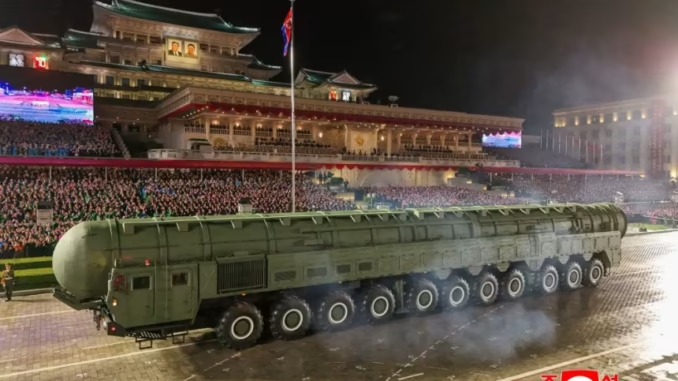
South Korea’s top military officer has raised concerns that North Korea may have received Russian assistance in developing its newly unveiled Hwasong-20 intercontinental ballistic missile (ICBM).
During a parliamentary audit session on Tuesday, Chairman of the Joint Chiefs of Staff (JCS) Gen. Jin Yong-sung told lawmakers there is “sufficient possibility” that Russia supported North Korea’s ICBM program, citing changes in transporter erector launcher (TEL) design and the deepening military cooperation between the two countries.

The Hwasong-20 was revealed last week during a military parade in Pyongyang marking the 80th anniversary of the ruling Workers’ Party of Korea. It appeared alongside a range of new weapons, including a hypersonic missile and multiple launch platforms for attack drones, reflecting North Korea’s continued push to diversify its strike capabilities.
Gen. Jin pointed to visible differences in the TEL used for the Hwasong-20 compared to that of the Hwasong-19, first test-launched in October 2023. The changes, he suggested, raise questions about foreign technical involvement.
“I believe there is sufficient possibility,” Jin said, when asked if the North’s advances could be linked to Russian support.
The suspected missile cooperation follows a series of publicized meetings and arms transactions between Moscow and Pyongyang in recent months, including reported transfers of artillery shells and ballistic missiles from North Korea to support Russia’s war in Ukraine.
North Korea has called the Hwasong-20 “the most powerful nuclear strategic weapon system,” but its operational status and range capabilities have not been independently verified.
When asked about South Korea’s ability to defend against North Korea’s new hypersonic missile, Jin acknowledged that interception “may slightly falter,” but stated, “they can be intercepted.”
He stressed that while the North’s evolving capabilities are cause for concern, the South Korean military is preparing responses and pursuing further technical verification of the new systems.
To support its monitoring and early-warning posture, South Korea has expanded its satellite reconnaissance capability. Jin confirmed that the military is leveraging both military and commercial satellites to increase the frequency and coverage of surveillance.
“I believe it is important to take in information in a short time and in a repeated manner, using not only military reconnaissance satellites but civilian satellites,” Jin said. “We are pushing to do so.”
South Korea launched its first spy satellite in December 2023, equipped with electro-optical and infrared sensors. Since then, it has placed three additional satellites into orbit, each equipped with synthetic aperture radar (SAR) systems capable of collecting imagery regardless of weather or lighting conditions.
The country plans to launch a fifth satellite later this year, completing a network that will allow South Korean forces to monitor North Korea every two hours, a major step forward in persistent surveillance coverage.
The remarks come amid increasing concerns in Seoul and Washington over the strategic consequences of renewed DPRK-Russia military alignment, which appears to be yielding technical and operational benefits for both sides.
© 2025, GDC. © GDC and www.globaldefensecorp.com. Unauthorized use and/or duplication of this material without express and written permission from this site’s author and/or owner is strictly prohibited. Excerpts and links may be used, provided that full and clear credit is given to www.globaldefensecorp.com with appropriate and specific direction to the original content.





